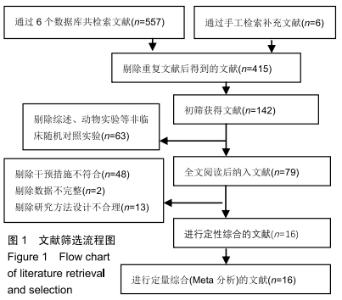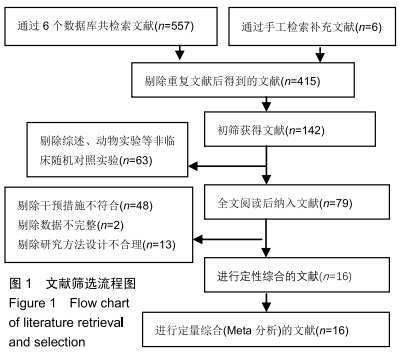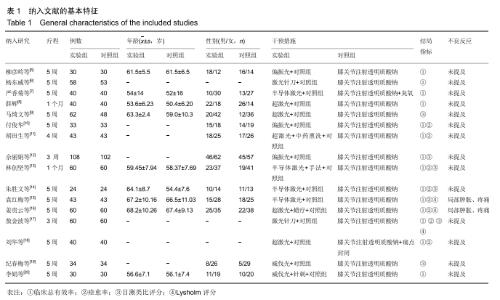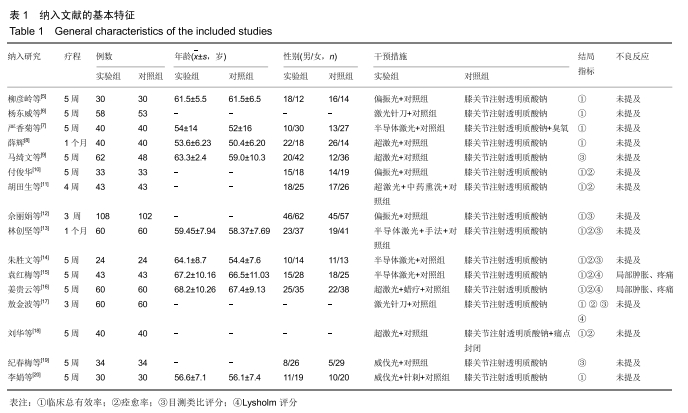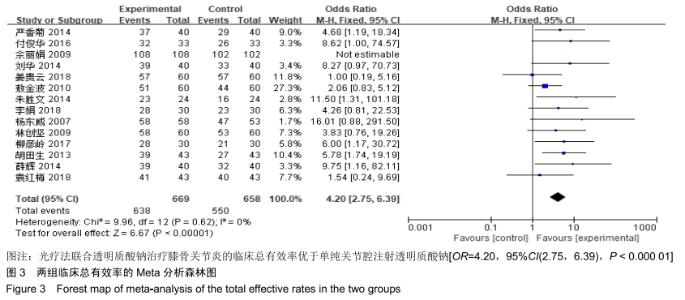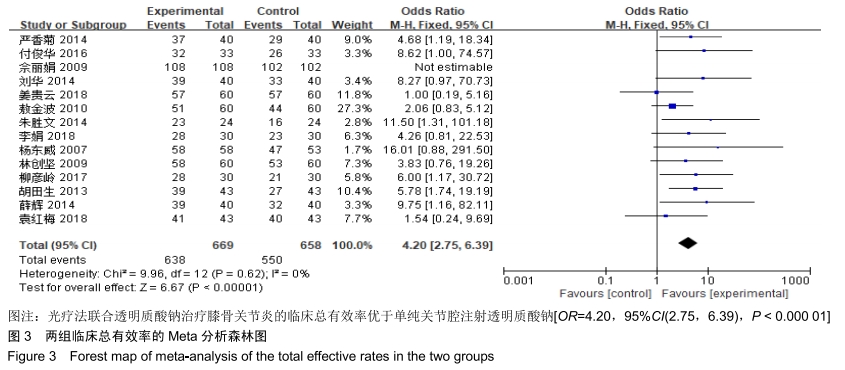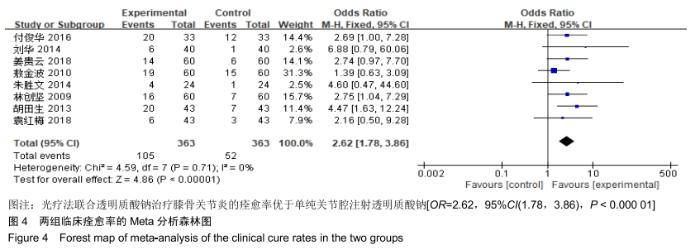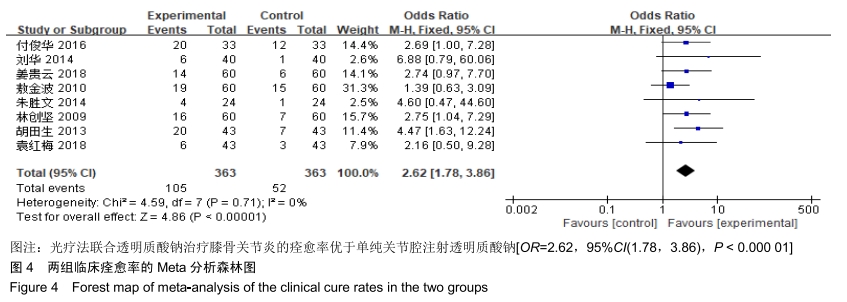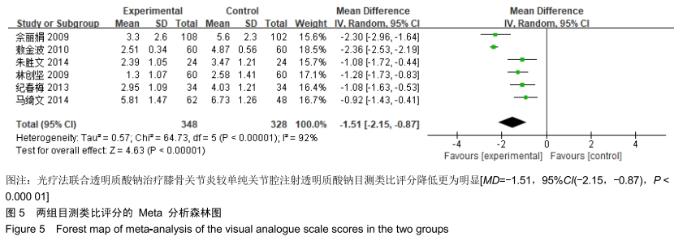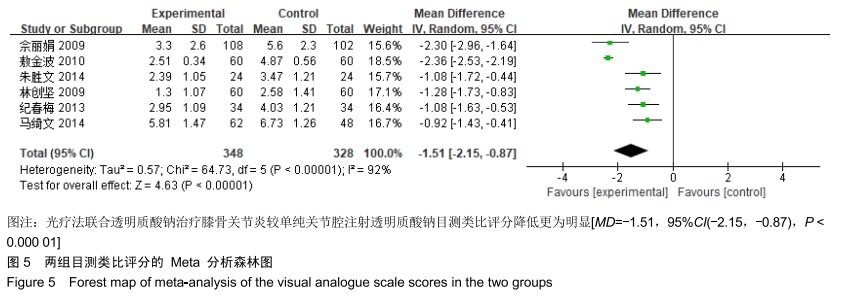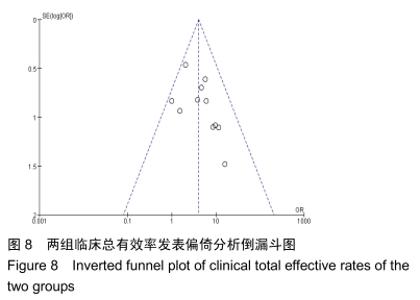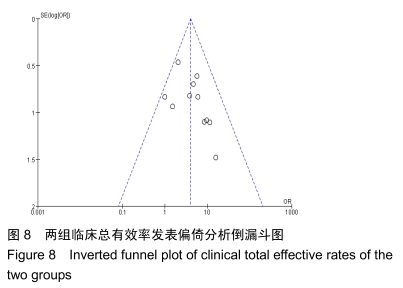[1] WANG H, ZHANG C, GAO C, et al. Effects of short-wave therapy in patients with knee osteoarthritis: a systematic review and meta-analysis. Clin Rehabil. 2017;31(5):660-671.
[2] ENE R, SINESCU RD, ENE P, et al. Synovial inflammation in patients with different stages of knee osteoarthritis. Rom J Morphol Embryol. 2015;56(1):169-173.
[3] 徐文斌,熊俊龙,戴文俊,等.物理因子干预治疗膝关节骨性关节炎[J].长春中医药大学学报,2015,31(6):1268-1271.
[4] ANNASWAMY TM, GOSAI EV, JEVSEVAR DS, et al. The Role of Intra-articular Hyaluronic Acid in Symptomatic Osteoarthritis of the Knee. PM R. 2015;7(9):995-1001.
[5] 柳彦岭,李士欣,于山.偏振光结合玻璃酸钠治疗退行性膝关节炎的效果研究[J].海峡药学,2017,29(12):151-152.
[6] 杨东威,王熙,孟彪.激光针刀配合关节腔注射治疗膝骨性关节炎[J].中医正骨,2007,19(12):12,14.
[7] 严香菊,司娜,童莉.多途径综合治疗膝骨关节炎的疗效观察[J].山西医药杂志,2014,43(8):900-902.
[8] 薛辉.超激光照射联合玻璃酸钠关节腔注射治疗膝关节骨关节炎疗效观察[J].医学美学美容(中旬刊),2014,23(9):63.
[9] 马绮文,欧英慧,黎志峰,等.超激光联合玻璃酸钠关节腔注射模式对骨关节炎疗效影响的分析[J].医药前沿,2014,4(13):161-162.
[10] 付俊华.偏振光联合关节腔内注射玻璃酸钠治疗退行性膝关节炎的临床疗效观察[J].当代临床医刊,2016,29(3):2186-2187.
[11] 胡田生,杨亚军,胡日鹤.超激光加中药熏洗配合关节腔内注射治疗膝关节骨性关节炎43例[J].湖南中医杂志,2013,29(5):14-16.
[12] 佘丽娟,王晓明,姚军,等.直线偏振光近红外线照射结合关节周围敏感压痛点注射治疗膝关节炎的临床观察[J].医学研究与教育, 2009,26(4):46-47.
[13] 林创坚,陈怀.局部综合疗法治疗膝关节骨关节炎临床观察[J].按摩与导引,2009,25(12):4-6.
[14] 朱胜文,邱波,游浩,等.激光联合玻璃酸钠注射治疗膝骨关节炎24例[J].中国中医骨伤科杂志,2014,22(12):54-55.
[15] 袁红梅,何增义.半导体激光照射联合透明质酸钠和运动疗法对膝关节骨性关节炎的疗效影响[J].激光杂志,2014,35(4):53,55.
[16] 姜贵云,鞠智卿,杨晓莲,等.玻璃酸钠关节腔内注射配合蜡疗和超激光治疗老年膝关节骨性关节炎60例[J].中国老年学杂志, 2013, 33(6):1397-1399.
[17] 敖金波,穆敬平,程建明,等.激光针刀配合玻璃酸钠膝关节腔注射治疗膝关节骨性关节炎60例疗效观察[J].中国中医急症,2010, 19(9):1503-1505.
[18] 刘华,饶安,徐冬梅,等.玻璃酸钠腔内注射联合红外偏振光治疗膝骨关节炎的临床观察[J].医学信息,2014,27(29):242.
[19] 纪春梅,李淑丽,马玲,等.威伐光照射结合关节腔注射玻璃酸钠治疗膝关节炎[J].世界最新医学信息文摘(电子版), 2013,13(18): 89-90.
[20] 李娟,习振文,郭应强,等.三联疗法治疗阳虚寒凝证膝骨性关节炎的临床疗效[J].西部中医药,2018,31(7):92-95.
[21] HUNTER DJ .Viscosupplementation for osteoarthritis of the knee. N Engl J Med. 2015;372(11):1040-1047.
[22] 包德明.膝关节骨关节炎的治疗进展[J].中医正骨,2014,26(12): 52-55.
[23] 卓映宏,章晓云,陈跃平.膝关节骨性关节炎外科治疗研究进展[J].现代中西医结合杂志,2018,27(28):3189-3192.
[24] 李炎,李钊伟,任荣,等.膝关节骨性关节炎治疗的研究进展[J].中国当代医药,2019,26(16):24-27.
[25] CHENG OT, SOUZDALNITSKI D, VROOMAN B, et al. Evidence-based knee injections for the management of arthritis. Pain Med. 2012;13(6):740-753.
[26] 廖瑛,张兴,周君,等.透明质酸对膝关节骨性关节炎相关细胞因子及生物标志物的影响[J].中国现代医学杂志,2019,29(4):33-38.
[27] GHOSH P, GUIDOLIN D. Potential mechanism of action of intra-articular hyaluronan therapy in osteoarthritis: are the effects molecular weight dependent? Semin Arthritis Rheum. 2002;32(1):10-37.
[28] BERT JM, BERT TM. Nonoperative treatment of unicompartmental arthritis: from bracing to injection. Clin Sports Med. 2014;33(1):1-10.
[29] UTHMAN I, RAYNAULD JP, HARAOUI B. Intra-articular therapy in osteoarthritis. Postgrad Med J. 2003;79(934): 449-453.
[30] ATIK OS. Can we treat knee osteoarthritis with photomedicine? Photomed Laser Surg. 2015;33(3):121-122.
[31] 刘大煌,冯前,梁恒晔,等.针刺配合超激光疼痛治疗仪治疗骶髂关节炎80例[J].按摩与康复医学,2014,10(1):64-65.
[32] 柳学勇,冉春风,刘盼,等.低强度聚焦超声与普通超声治疗创伤性膝关节炎的疗效比较[J].中华物理医学与康复杂志, 2011,33(12): 927-929.
[33] 程志鹏.超激光疼痛治疗仪照射联合益肾温阳推拿法治疗膝关节骨性关节炎60例临床观察[J].河北中医,2014,36(9): 1357-1358.
[34] 许丽华,牟朝晖,徐卫平,等.玻璃酸钠关节腔注射联合超激光治疗膝骨关节炎[J].浙江创伤外科,2012,17(3):338-339.
[35] 顾培洪.半导体激光联合阿昔洛韦治疗带状疱疹疗效观察[J].中国民康医学,2013,25(4):42-43.
[36] 陈哲明.现代实用激光医学[M].北京:科学技术文献出版社,2006: 456-457.
[37] 尼姆兹.激光与生物组织的相互作用原理及应用[M].张镇西,译.北京:科学出版社,2005:51-52.
[38] PEPLOW PV, CHUNG TY, BAXTER GD. Laser photobiomodulation of proliferation of cells in culture: a review of human and animal studies. Photomed Laser Surg. 2010;28 Suppl 1:S3-40.
[39] 王海铭,康静.威伐光WIRAOR治疗系统的临床应用研究及相关理论探讨[J].中西医结合心血管病杂志(电子版),2013,1(2): 12-13.
[40] 丁志清,丁勤能.威伐光结合等速肌力训练治疗老年膝关节骨性关节炎临床对照研究[J].中国医疗设备,2017,32(S1):57.
|
